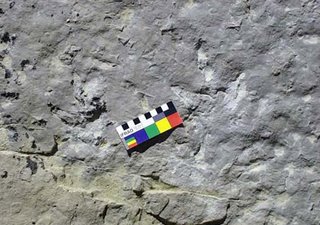
Larry O'Hanlon, Discovery News
Dino Model?
AP Photo/Lance Moler
Irma Quintero pets some of the emus that she raises on her farm outside Lubbock, Texas. Scientists recently watched emus walk to understand how dinosaurs walked thousands of years ago.
The mysterious moves of two-footed Jurassic dinosaurs traveling along a long-lost beach have been brought to life with emus.
Unlike computer models that have been developed to simulate the gait, and therefore the possible trackways of specific dinosaurs, live emus allow for direct comparisons of complex tracks to specific behaviors, say researchers looking at the thousands of tracks left behind 165 million years ago by dinosaurs at Red Gulch in northern Wyoming.
Among the surprises they’ve found is that tracks once interpreted as steady walking may actually be created by the animals stopping at mid-stride.
Another enigmatic type of trackway that now makes sense is where the dinos appear to have crossed one leg over the other. The motion is a seemingly weird thing to do, until you watch an emu making the same sort of track, explains Brent Breithaupt, director and curator of the University of Wyoming’s Geological Museum.
Emus, it turns out, have legs that are close together — like many dinos — and tend to look around a lot as they walk, Breithaupt explains. This scanning behavior causes emus to often cross the left foot over the right leg and the right foot over the left, making the same confusing pattern seen in the dinosaur trackways.
"Sure enough there are wonderful comparisons," said Breithaupt. "Emus are our biological Rosetta Stone."
He presents the latest on emus as proxies for dinosaurs on Oct. 25 at the annual meeting of the Geological Society of America in Philadelphia.
The search for a modern animal to act as a proxy for dino tracks started, says Breithaupt, because he was getting a little impatient with all the speculation about the trackways. There was too much of what he calls "prehistoric hyperbole."
So after passing on ostriches, which have only two toes, or rheas, which have three-toes but overly rambunctious personalities, emus remained as the best alternative. Plus there was an emu ranch just across the state line in Colorado.
Breithaupt and his team now think that the Red Gulch dinosaurs were probably man-sized meat-eaters, or theropods, which were traveling along in groups. The groups may have included families, since there are juvenile and adults tracks together, implying some sort of parental care.
Exactly what the dinosaurs looked like, however, is a mystery because the mid-Jurassic Period is particularly poor in dinosaur fossils in North America.
"There is virtually nothing known about dinosaurs in North America from that time," said geologist Erik Kvale, who discovered the tracksite and did a great deal of the first geological work there. "Chances are there were some very gregarious behaviors of dinosaurs (at Red Gulch), but it's only a snapshot."
What can be said with more certainty is that the dinosaurs were walking in a very different landscape than today, says Kvale. The sands beneath their feet were carbonate sands like those found in the Bahamas or the Florida Keyes, but the climate of the ancient shoreline was probably a lot drier.
"The Persian Gulf is a better analogue," said Kvale.
 BLM Wyoming
BLM WyomingAncient Print
The angular shapes in this image are salt crystals formed when the beach dried after the dinosaur tracks were made. These crystals give scientists information about the air temperature and relative humidity which help with the environmental reconstruction.
Reference:Discovery
No comments:
Post a Comment